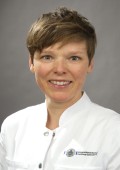Research group Epigenetics
The research group epigenetics focuses on the mechanisms that regulate human genome behaviour. These mechanisms are primarily responsible for generating cell-type specific gene expression profiles, which give rise to the large variety of cellular identities with diverse functionalities in the human body. Changes in epigenetic regulation are often at the core of pathological processes that lead to cellular dysfunctionality and result in organ malfunction and disease.
We are funded through BMBF/German Center for Infection Research (DZIF), the Medical Faculty of the University of Hamburg and GILEAD Sciences
Research projects
Crosstalk of proviral DNA with the human genome in chronic infection with human immunodeficiency virus (HIV)
A variety of human pathogenic viruses can enter a state of viral latency upon infection. This dormant state is thought to enable evasion from immune surveillance, permits long term persistence of the viral genome within the host cell and establishment of a chronic infection.
HIV replicates through integration of proviral DNA into the genome of infected cells. This viral life cycle has several intriguing features. Integrated proviral sequences can be transcriptionally repressed, resulting in a latently infected reservoir that is hampering current efforts to eradicate HIV once infection has occurred. Furthermore, chronically HIV-infected patients accumulate a large number of defective proviral sequences within the genomes of HIV target cells. Very little is known to date about the impact of these sequences on host cell biology.
The research project focuses on the mechanisms that govern choice of HIV integration site as well as HIV latency establishment and maintenance. Particular emphasis is put on epigenetic regulatory mechanisms. Generally we would like to understand how HIV proviral DNA integration impacts on host cell physiology.
In order to approach these questions, we employ a range of molecular biology techniques, focusing in particular on the analysis of local and genome-wide epigenetic and translational changes. We make use of site-specific targeting technologies (e.g. genome editing) in order to generate suitable cellular model systems.
Overall, we expect that our studies will promote our understanding of the biology of HIV infection and in particular of the impact of chronic infection on human host physiology. Eventually this understanding will be essential to optimize therapeutic strategies.
The proviral integration site landscape in chronic infection with human immunodeficiency virus (HIV)
Chronic HIV-1 infection is characterized by accumulation of proviral sequences that have integrated into the genome of HIV target cells. Selection of integration sites of viral-derived DNA is non-random and appears to be re-shaped through selection pressures during prolonged HIV infection controlled through antiretroviral therapy. Much interest in the field of HIV research has focused on the identification of proviral integration sites in chronically HIV-infected individuals. These studies have for example revealed that proviral DNA preferentially integrates in certain so-called recurrent integration genes of the human genome. The pathogenic importance of observed integration site distribution is currently unknown, but there are indications that the site of integration might influence viral latency establishment and maintenance as well as HIV reservoir dynamics.
We are using different bioinformatics approaches to gain a comprehensive overview of observed viral-derived integration site distribution and characteristics in chronic HIV infection. We compile data from multiple integration site studies, which we submit to genome-wide analysis with particular emphasis on epigenetic and genetic features associated with proviral integration. We will also make use of a DZIF-led biobank for chronic HIV-infection to probe our data.
In general, we anticipate that our studies will provide a more complete understanding of how the proviral integration site landscape in chronic HIV infection might impact on pathological processes observed in chronic HIV disease. Eventually this understanding is necessary to optimize therapeutic strategies.
Endogenous retroviruses (ERV) in human disease
For millions of years viruses exist alongside their hosts and adapt continuously with them. The evolution of humans has also been accompanied by viruses and will in future also further be influenced by viruses. Retroviruses constitute a special virus class, that is capable to integrate their viral genome irreversibly into the genome of the human host. Hence, a retroviral infection not only elicits an immunological host reaction, but also leads to a permanent modification of the human genome. Several examples exist, where such integration contributes to pathogenesis and results in a clinical manifestations (e.g. leukemia).
However, coevolution between man and retrovirus is not solely a one-sided relationship in which the human host suffers from viral infection. Indeed, over the course of time, the human genome has accumulated many retroviral sequences that have become useful and essential genomic parts. These mutated and adapted retroviral sequences are termed endogenous retroviruses (ERVs). Mutational changes have made them incapable to form nascent infectious viral particles, while they have often retained the capacity of regulatory genetic elements. About 8% of the human genome are currently denoted as ERV sequences and a considerable number of human genes is regulated by such elements.
Our research aims to understand how ERVs are regulated and function in the context of different pathological manifestations. State of the art methods for the first time allow ERV-specific expression analysis and characterization of epigenetic profiles on a genome-wide level. We are using next generation sequencing (NGS) techniques and adapted bioinformatics algorithms to assess the status of over 3200 ERV elements. The acquired data will yield a more detailed view of regulatory ERV networks and the dynamics of ERV/human genomic balance.
We focus for example on changes in ERV expression upon acute and latent HIV infection, respectively. Obtained insights will in future be transferred to a broader context, elucidating ERV-mediated effects in other pathologies, such a sepsis and chronic inflammation.

